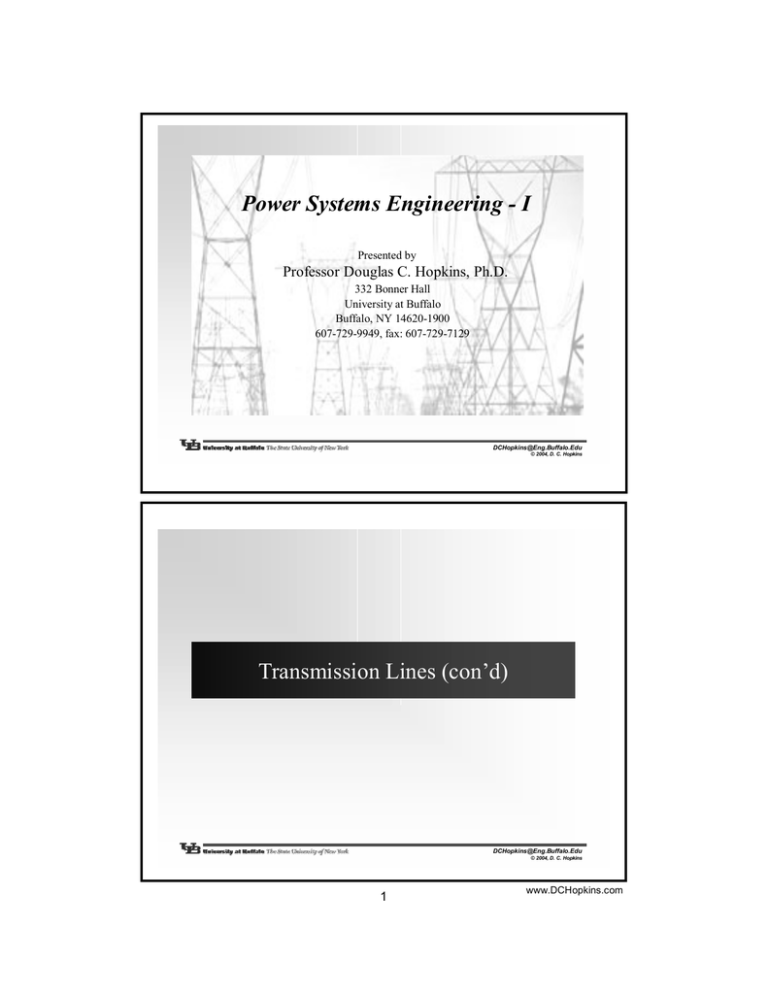
Power Systems Engineering - I
Presented by
Professor Douglas C. Hopkins, Ph.D.
332 Bonner Hall
University at Buffalo
Buffalo, NY 14620-1900
607-729-9949, fax: 607-729-7129
DCHopkins@Eng.Buffalo.Edu
© 2004, D. C. Hopkins
Transmission Lines (con’d)
DCHopkins@Eng.Buffalo.Edu
© 2004, D. C. Hopkins
1
www.DCHopkins.com
Review Nomenclature
Characteristic impendence, Zc = √ (z/y)
Propagation constant, γ = √ (yz) = α+jβ
Attenuation constant is α
Phase constant is β
For lossless line, R=G=0, i.e.
Zc = √(L/C)
γ = jω√(LC) = jβ
Also wavelength, λ = 2π/β
DCHopkins@Eng.Buffalo.Edu
© 2004, D. C. Hopkins
Closer Look at Transmission Lines
The exact equations (p218) give the V(x) and I(x) at any
point along the line.
VR + Z c I R α x j β x
e e
2
V + Zc I R α x jβ x
I ( x) = R
e e
2Z c
V ( x) =
VR − Z c I R −α x − j β x
e e
2
V − Z c I R −α x − j β x
e e
− R
2Zc
+
where γ = α+jβ
eαx changes the magnitude with distance.
ejβx changes the phase angle with distance.
DCHopkins@Eng.Buffalo.Edu
© 2004, D. C. Hopkins
2
www.DCHopkins.com
Incident Wave
V + Zc I R α x j β x
V ( x) = R
e e
2
S
R
X=0
The first term diminishes in magnitude and retards in
phase moving from source end to receiving end.
This is a “traveling wave,” specifically the “incident
wave.”
DCHopkins@Eng.Buffalo.Edu
© 2004, D. C. Hopkins
Reflective Wave
S
V − Z c I R −α x − j β x
+ R
e e
2
R
X=0
The second term increases magnitude and advances
phase as moving from source end to receiving end.
This is a “traveling wave,” specifically the “reflective
wave.”
DCHopkins@Eng.Buffalo.Edu
© 2004, D. C. Hopkins
3
www.DCHopkins.com
Line Termination with Zc
If a line is terminated into its characteristic impedance,
Zc, there are no reflections.
The line is called a “flat line” or “infinite line.”
– Usually, power lines are not terminated into Zc,
though communication lines most often are.
Typical Zc=400Ω for single-circuit overhead lines with
a phase angle between 0 and –15°.
The characteristic impedance, Zc, is called the
surge impedance if the line is considered
lossless.
DCHopkins@Eng.Buffalo.Edu
© 2004, D. C. Hopkins
Surge Impedance Loading (SIL)
SIL is the power delivered by a lossless line to a load
resistance equal to the Zc=√ (L/C) [real ohms]
At SIL the IR=VR/Zc , then
V(x) = cos(βx) VR + j Zc sin(βx) (VR/Zc)
=(cos(βx) + j sin(βx)) VR
=ejβx VR [volts]
|V(x)| = | VR |
I(x)
=(cos(βx) + j sin(βx)) VR /Zc
=ejβx VR /Zc [amps]
DCHopkins@Eng.Buffalo.Edu
© 2004, D. C. Hopkins
4
www.DCHopkins.com
SIL Power
The complex power flowing at any point along in line is
S(X) = P(x) = jQ(x) = V(x) I*(x)
= ( ejβx VR ) (ejβx VR /Zc )*
=|VR 2 | / Zc
The real power delivered at rated line voltage, SIL, is
SIL = V2rated / Zc
where Zc = √(LC)
DCHopkins@Eng.Buffalo.Edu
© 2004, D. C. Hopkins
Maximum Power expressed in SIL
Power system stability may be defined as that property
which enables the synchronous machines to
adequately respond to a disturbance from a normal
operating condition.
Or: The generator cannot deliver more power, otherwise
it looses synchronism.
The maximum power flow per unit SIL is
Pmax / SIL = VS,pu VR,pu / sin(2π lλ)
where lλ is the fraction of line length relative to
wavelength (λ = 2π β)
DCHopkins@Eng.Buffalo.Edu
© 2004, D. C. Hopkins
5
www.DCHopkins.com
Maximum Power Flow per unit SIL
Graph scales with VS and VR. A 95% line drop directly
affects the max flow.
Maximum Power/SIL
6.00
Maxflow(W)/SIL(W)
5.00
4.00
3.00
2.00
1.00
0.00
0
0.05
0.1
0.15
0.2
0.25
Fraction of Wavelength (m/m)
DCHopkins@Eng.Buffalo.Edu
© 2004, D. C. Hopkins
Line Loading
DCHopkins@Eng.Buffalo.Edu
© 2004, D. C. Hopkins
6
www.DCHopkins.com
Practical Limit on Line Loading
• Thermal limits
– limit is due to heating of conductor and hence depends
heavily on ambient conditions
• Angle limits
– while the maximum power transfer occurs when line angle
difference is 90 degrees, actual limit is substantially less
due to multiple lines in the system
• Voltage stability limits
– as power transfer increases, reactive losses increase as I2X.
As reactive power increases the voltage falls, resulting in a
potentially cascading voltage collapse.
• Review Examples
© 2003 Tom Overbye, University of
Illinois at Urbana-Champaign,
DCHopkins@Eng.Buffalo.Edu
All Rights Reserved
© 2004, D. C. Hopkins
Reactive Compensators
• Compensation affects steady-state and dynamic
control
• Passive compensators
– Shunt inductors and capacitors
• Active compensators
– Rotational
– Switched passive elements
– FACTS
• Review example
DCHopkins@Eng.Buffalo.Edu
© 2004, D. C. Hopkins
7
www.DCHopkins.com
Good Bye
You have all been a great class. Your interest, questions
and humor have made this one of the most interesting
classes I have taught.
You are all above average, if only in the fact that you
seek personal improvement. I wish you all well in
your future studies and I stand ready to continually
help you meet your goals.
Dr. Doug Hopkins
DCHopkins@Eng.Buffalo.Edu
© 2004, D. C. Hopkins
Farwell
DCHopkins@Eng.Buffalo.Edu
© 2004, D. C. Hopkins
8
www.DCHopkins.com

